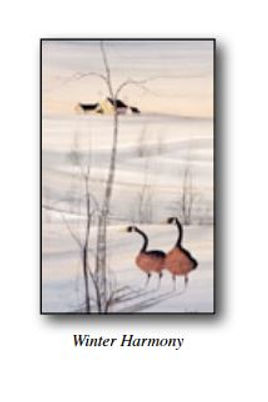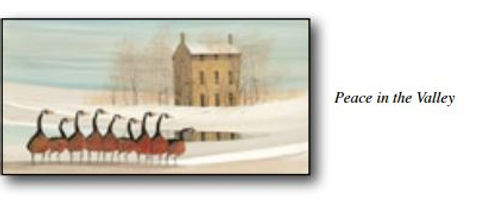
Wednesday thru Friday 10 AM -1 PM
Saturday 10 AM - 12 PM
or by appointment
upon further investigation...


I once asked Pat Moss how long it takes to paint a picture.
Her answer, “My whole life.”
Every painting is a culmination of the artist’s life: her beliefs, training, education, experiences, hopes, dreams; her desire to share with the viewer her insight as to what she sees, thinks, believes and feels when she creates a painting.
Hopefully I can take you on a journey that begins to explain the deeper symbolism (the story within the story) that exists in Pat Moss’ artwork - giving you a greater appreciation and clearer understanding of the artist and her work.
Our journey shall begin with the goose - one of Pat’s most recognizable and identifiable images, or perhaps I should say “icons” in her paintings. Sometimes she paints a single goose; sometimes a pair of geese; and other times an entire gaggle.
A Moss goose, while depicting the identifiable goose shape, always has an elongated style, as do her people. The color often varies from rich golden brown and black tones to gray and silver tones; and sometimes they are even blue. But whatever their color, their heads are held high expressing an attitude of self-confidence, the qualities of a committed leader; and however they are painted, the Moss goose is always a source of inspiration.
You may recognize that Pat’s single goose oftentimes seems to be looking for direction. The collector of her work instinctively knows that the right direction will not only be found but also taken by this little fellow.
In Christian iconography, the goose was recognized as a symbol of loyalty and divinity. I’ve often heard when geese mate, they mate for life. Whether that is true or not, in real life both the male and female goose work together to share the responsibility of building and feathering a nest for their offspring; and as a pair they commit to feeding and raising their gosslings.
In Moss iconography, geese in pairs represent fidelity and loyalty - having a partner to share life - having a best friend - someone to rely upon, to talk to, to confide in; someone to make a home with; someone to both laugh and cry with. On more than one occasion I have walked in areas where there was a gaggle of geese, usually feeding or resting. I am always fascinated to watch them.
The flock eats in peace while the sentry watches over them, protecting and guarding them, knowing that in a short while another goose will take his place as sentry so that he, too, can eat and rest to be able to lead his gaggle to the next destination.
And yes, it is true that Pat’s geese do not show their feet. Medieval theologians were concerned about the goose, that perhaps the goose was a symbol of sin because of its webbed feet - surely geese were a sign of the devil. But later, in Christian iconography, geese became a symbol of vigilance, perseverance, loyalty. So, whether it is a conscious decision on the part of the artist or an unconscious one, or because of her study of Medieval art history, most of Pat’s geese do not show their feet.
The next time you are outdoors on a crisp fall day, and you hear the faint, honking sounds of a flock of geese flying overhead in a V- formation, consider the symbolic P. Buckley Moss goose, leading his flock to shelter, food and safety, knowing he has taken the right direction.
Patricia Buckley Moss’ artwork always tells a story; but often times the story within the story is dependent upon further investigation - to understand what else she hopes to convey. The story within the story is what makes so many of us collectors, not just owners, of her work.
NEXT TIME our journey will take us to landscapes - quiet, peaceful places, which really do have a lot to say.
Thanks for reading,
liking and sharing;
and until next time,
Carolyn
as a sidelight…
Many years ago, I had a first time customer, who came into the gallery just to browse. After a few minutes, I noticed that she was looking at a small goose etching, and she was crying. I hardly knew what to say because I had never met her and had no idea why she was crying.
But I walked over to her and asked if she was all right. She said yes and she apologized for the tears. I asked what made her cry.
She told me the story of how she had been kidnapped off a parking lot and assaulted before being released. Although she had escaped with her life, her life was in shambles. She had been through counseling with her priest and other professional counselors, and her family had been very supportive; but she just could not get past the fear of what had happened to her.
The day she visited my gallery was the first day that she had decided she had to venture out on her own and decide what road she needed to take in order to make her life somewhat normal and whole again.
She told me that little goose was providence. She told me she was that little goose trying to decide which road to take, trying to decide what to do with her life. She bought the artwork. I saw her only once after that. She was still working on getting back to normal, but that little goose, trying to decide which road to take, was her link to becoming whole again.
I can assure you that when Pat created that little etching, she had no idea what a divine, profound, emotional and inspirational impact that little goose, looking for direction, would have on someone.
That day certainly changed the manner in which I view artwork; and since that day, Pat’s artwork has served to inspire me EVERYDAY.

